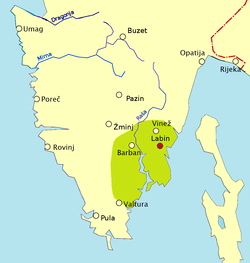Albona Republic
| Albona Republic Labinska republika | |||||||||
|---|---|---|---|---|---|---|---|---|---|
| 1921 | |||||||||
 Flag
 Coat of arms
| |||||||||
|
Motto: "Kova je nasa" "The mine is ours" | |||||||||
 Map of Albona Republic (in green) within Istria, 1921 | |||||||||
| Status | Unrecognized state | ||||||||
| Capital | Albona | ||||||||
| Common languages | Croatian and Italian | ||||||||
| Government | Republic | ||||||||
• Head of the miners committee | Giovanni Pipan | ||||||||
• Commander of the Red Guard | Francesco Da Gioz | ||||||||
| Historical era | Interwar period | ||||||||
• Established | March 2 1921 | ||||||||
• Disestablished | April 8 1921 | ||||||||
| Currency | Italian lira | ||||||||
| |||||||||
| Today part of |
| ||||||||
The Albona Republic (Croatian: Labinska republika) was a short-lived self-governing republic that was proclaimed by miners from Istrian city of Albona on March 2, 1921 during a mining strike. It was created in what has been described as the world's first anti-fascist uprising.[1]
History
With the collapse of the Austro-Hungarian Empire following the end of the First World War, Italy was given the regions of Istria and parts of Dalmatia as part of the Treaty of Saint-Germain as promised in the Treaty of London by the Triple Entente.[2] Italy began to revitalize and exploit the population and economic potential of the occupied territories.
Before Mussolini's March on Rome in Italy, fascists occupied headquarters of the Workers' Committee in Trieste in 1921, lit it on fire and attacked representatives of the Raša Mining Trade Union. With regard to this event and the former exploitative relationship with mine workers of Labinština mines, a general strike of about two thousand miners broke out. Miners proclaimed the republic in the occupied mines under the motto 'Kova je nasa' (The mine is ours), organized government and the so-called red guard as a protection from the italian law enforcement and started to manage the production of mines by themselves with the support of a part of farmers. On April 8, 1921, Italian administration in Istria decided to suppress the republic using the military force, and eventually succeeded after suppressing the strong resistance of the miners.
Other
The Albona Republic also existed as part of the Roman Empire. As a Republic, Albona had two government officials nominated in Rome, the capital of the Roman Empire.[3]
See also
References
- ↑ http://arhiva.nacional.hr/clanak/103396/turisticka-atrakcija-u-istri-i-hrvatska-ce-imati-podzemni-grad-i-to-u-labinu
- ↑ Moos, Carlo (2017), "Südtirol im St. Germain-Kontext", in Georg Grote and Hannes Obermair, A Land on the Threshold. South Tyrolean Transformations, 1915–2015, Oxford-Berne-New York: Peter Lang, pp. 27–39, ISBN 978-3-0343-2240-9
- ↑ Labin, Yugoslavia (1870). Societa del Gabinetto di Minerva, ed. Statuto municipale della città di Albona dell'a. 1341 (in Italian) (1341 ed.). Trieste: Società del Gabinetto di Minerva,. pp. III–XVI. Retrieved August 19, 2013.
- (in Italian) G. Scotti, L. Giuricin, La Repubblica di Albona e il movimento dell'occupazione delle fabbriche in Italia.
Further reading
- "Labinska republika". Istarska enciklopedija (in Croatian).